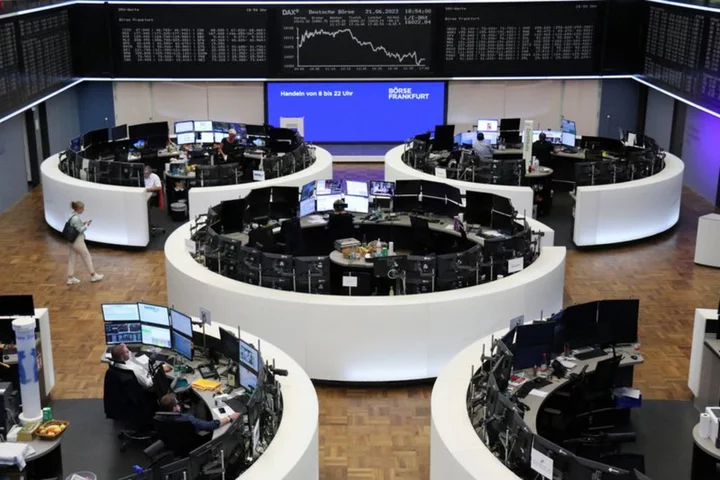By Mike Dolan
LONDON The scale of the debt market reaction to October's U.S. inflation undershoot partly reflects sheer relief in what's now one of the biggest bond market bets of the century so far.
While headline and 'core' annual consumer price inflation rates were just 0.1 percentage point below forecast, at 3.2% and 4.0% respectively, it's enough to re-fire the disinflation story, cement peak Federal Reserve rates here and add a quarter-point rate cut into the futures curve for 2024.
With inflation expectations waning in the background and gas prices down almost 20% in two months, economists were quick to point out that ebbing shelter costs and goods prices also meant core CPI is now down to an annualised 2.8% over five months.
"The immaculate disinflation continues," said Lazard chief strategist Ronald Temple. "Absent any exogenous shocks, the Fed is increasingly likely to be in a position to cut rates in the second quarter of 2024."
A recently edgy bond market gobbled all that up.
Stoked by news just before the release that Congress was set to avoid a long-feared government shutdown later this week, two-year Treasury yields fell a whopping 20bp - the biggest one-day drop in almost four months - and 10-year yields fell to their lowest in seven weeks at 4.43%. That's almost 60bps down from 16-year highs set just over 5% on Oct. 23.
Earlier in the day, Bank of America's influential global funds survey revealed how more and more asset managers think cresting bond yields offering the best rates in over a decade are now a steal despite three bruising years of capital losses.
Reflecting back on an era now famed in literature for "The Big Short", the survey showed global funds had amassed their biggest overweight in bonds since just after the banking crash 15 years ago. Almost two thirds of respondents now think yields will be lower in a year's time - the most in the 20-year survey history - and 80% see lower short rates - the most since 2008.
Funds' bonds allocation in November soared 18 points over the month to leave them net 19% overweight - almost 3 standard deviations above long-term averages. Only March 2009 and December 2008 showed larger overweights in bonds.
But in perhaps a reflection of how many see 2024 as the year of 60/40 asset funds as much as bonds - given that a boom in bonds sinks long-term borrowing costs too, relieves indebted firms and flatters stock valuations - the BofA survey also clocked a first overweight in global equity since April 2022.
And the S&P500 roared ahead after Tuesday's inflation report and bond yield swoon, topping intraday gains of more than 2% for the first time since June.
"That print does not see the end of inflation, but is a definitive hint in that direction," said Lombard Odier's Florian Ielpo. It's "supportive of equities, credit and duration - lowering notably the risk that markets feared the most: overtightening."
'MARGIN OF SAFETY'
While the doubling down on long-term bond allocations is not exactly a leveraged bet about to hit the jackpot, there are elements of that scenario that may trigger speculative squeezes of sorts.
Asset managers' overweight bond positions - or at least those in government bonds and U.S. Treasuries - tends to be mirrored by big short positions in Treasury futures among speculative hedge funds.
There are many reasons cited for that - one of which is that asset managers tend to build bond positions via futures before sourcing cash bonds later on and hedge funds on the other side of that trade use short futures trades to arbitrage anomalies between cash and futures prices.
CFTC numbers show the scale of that speculative 'Big Short' on the flipside of the mounting 'Big Long' built by regular asset managers. And positive inflation surprise days like this Tuesday may well seed outsize Treasury moves that reflect some scramble on those shorts.
Either way, the regular investment world seems happier than ever to load up on bonds even after more than 20% losses on benchmark Treasury exchange traded funds in little over three years.
Pointing to elevated yields on corporate, emerging market and even 'safe' Western government bonds, Schroders strategist Duncan Lamont points out the additional 'margin of safety' that bonds now offer - basically how much of a rise in yields that can be absorbed over a 12-month horizon before investors lose money on the capital hit from the countervailing price drop.
Lamont points out that U.S. Treasury yields and investment grade corporate debt yields would have to rise about another 100bps for the capital losses to wipe out current yields. What's more, speculative high yield can absorb a rise of as much as 2.4 percentage points and emerging market debt 1.5 points.
"It doesn't eliminate risk but it does add a larger safety blanket than at any point for years," he wrote.
It's unlikely to be all smooth sailing from here and disinflation may not always be so 'immaculate'. Even if it continues apace, the Fed seems minded not to allow markets to loosen up lending too quickly.
"History is littered with examples of inflation aftershocks when central banks prematurely claim victory, cut rates too quickly, and create the conditions for another inflation spike," opines Glenmede strategist Jason Pride. "The Fed will likely be attuned to this risk and keep rates higher for longer to avoid such an outcome."
But judging by the increasing confidence of bond bulls, the assumption is that Fed hawkishness is just a rearguard action from here on in and more days like these lie ahead.
The opinions expressed here are those of the author, a columnist for Reuters.
(Writing by Mike Dolan; Editing by Susan Fenton)









